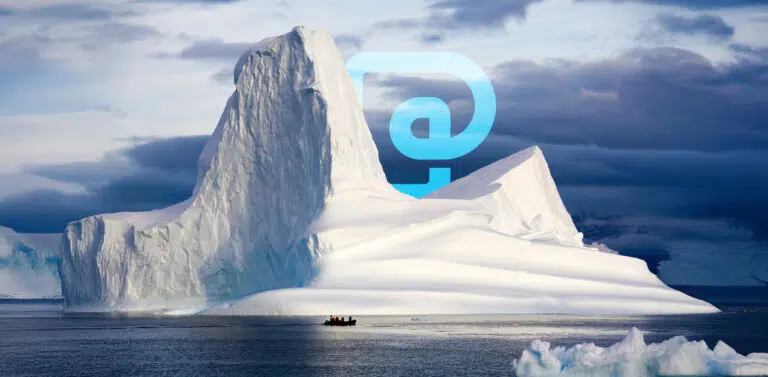Welcome to this guide on Antarctica wildlife created by our first-hand experience of exploring Antarctica. Through this guide, you will:
- Learn about Antarctica’s unique ecosystem
- See our top 21 Antarctic animal species and where they live
- Learn about conservation and threats wildlife in Antarctica faces
- Our best advice for wildlife watching in Antarctica
Let’s get started!
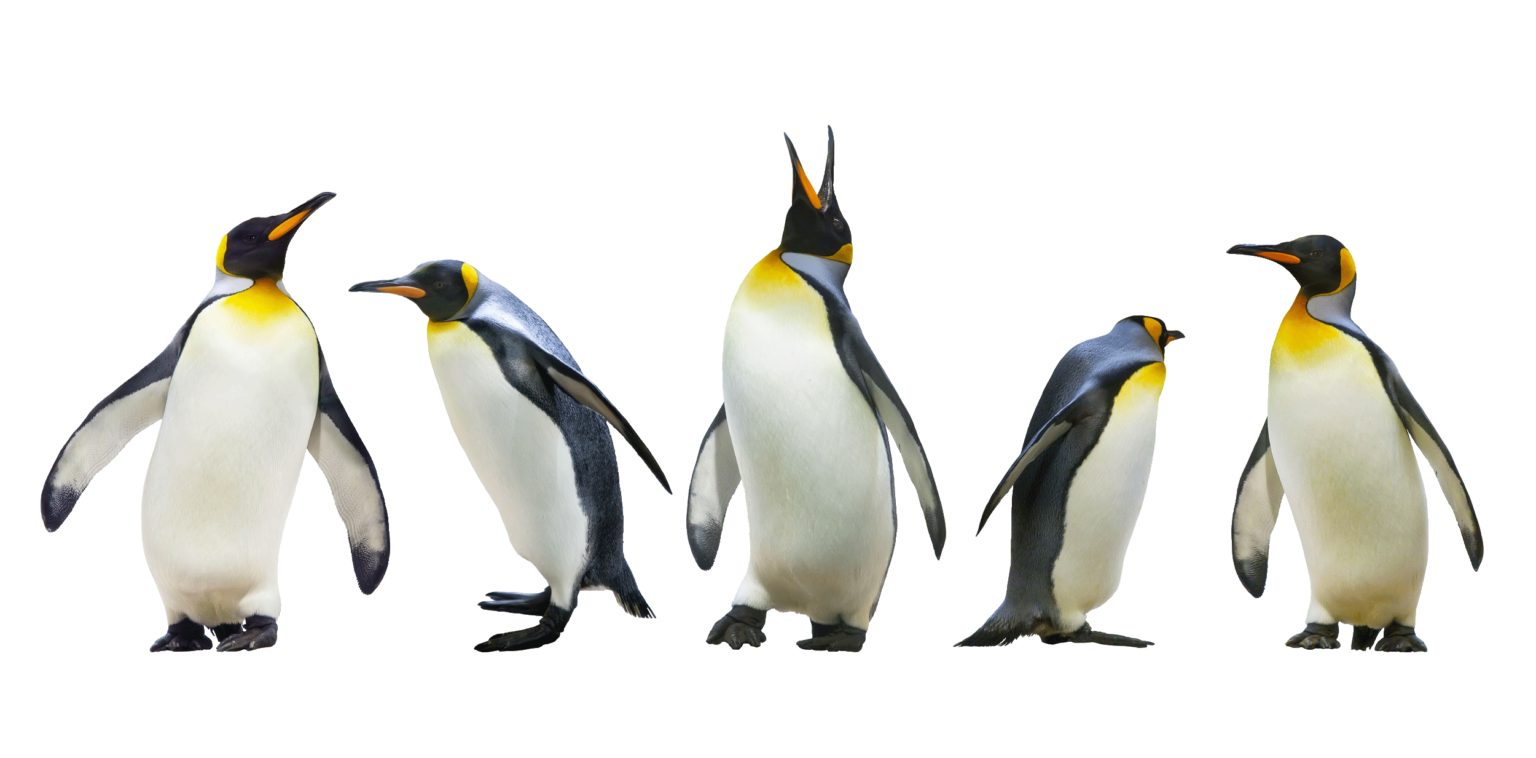
Table Of Contents
Each year, visitors are drawn from all over the world to witness the great abundance of Antarctica wildlife. Although Antarctica is known for its harsh climate and weather conditions, it’s home to many animal species that can’t be seen anywhere else on Earth.
Here is a quick overview of Antarctica’s wildlife:
- Antarctica is the only continent without terrestrial mammals, reptiles, or amphibians, but it is rich in birds and marine mammals that have adapted to its harsh environment.
- Fauna in Antarctica is less diverse than in other polar regions due to the cold climate.
- There are 235 animal species in Antarctica, and endemic species include emperor penguins, Adélie penguins, Weddell seals, and the pink-faced sheathbill, the only bird native to Antarctica.
- The Southern Ocean surrounding Antarctica has over 320 fish species, including snailfish, icefish, eelpouts and Antarctic cod.
- Antarctica has seven penguin species (8 if you include the sub-Antarctic).
- Antarctica has six pinnipeds (seals) species, including ross, crabeater, and Antarctic fur seals.
- Antarctic Krill (Euphausia superba) are the most abundant species in Antarctica (and one of the most abundant on Earth). They are a crucial part of the ecosystem and Antarctic food web.
- Earthworms and micro-invertebrates are also found in Antarctica.
- Only a few species, such as Emperor Penguins, stay in Antarctica all year round. Most Antarctic wildlife migrates north during the long, harsh winters.
A great way to see Antarctic wildlife is on an expedition cruise. Here at Polar Escapes, we offer the largest selection of wildlife-watching cruises to Antarctica.
Now that we have the basics let’s look at Antarctica’s unique ecosystem.
An Overview of Antarctica’s Ecosystem
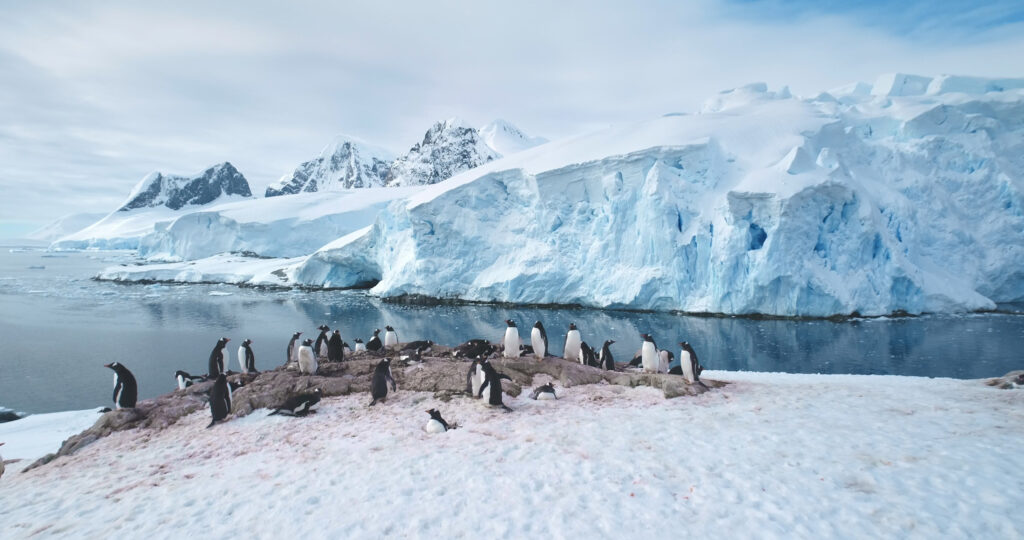
Despite its incredibly harsh conditions, Antarctica has a complex and thriving ecosystem that supports well-adapted wildlife in the sea and on land.
A lot of this is thanks to the Antarctic Ocean (also known as the Southern Ocean), which is rich in nutrients and one of the most stable environments for life. However, the threat of climate change means that the sea ice is reducing.
The Ocean is filled with important species, such as krill, which is essential to the diet of many Antarctic predators. On land, plants such as mosses, grasses, and lichens are vital parts of the ecosystem, too. Did you know Antarctica has over 1,150 fungi species, and algae form the base of many of Its food webs?
The Antarctic ecosystem is a crucial area of study for climate scientists and researchers, and it helps them predict climate shifts.
So, let’s meet the animals that live in Antarctica and that you are likely to see on an Antarctic cruise.
Penguins
Antarctica is one of the best places in the world to spot penguins in the wild. Eight of the 18 penguin species on Earth live in Antarctica and the surrounding sub-antarctic islands. Penguins spend most of their life in the water, where they feed off fish, krill and squid and can swim up to 25mph.
These are the penguins you might be lucky enough to see on a trip to Antarctica:
1. Emperor penguins
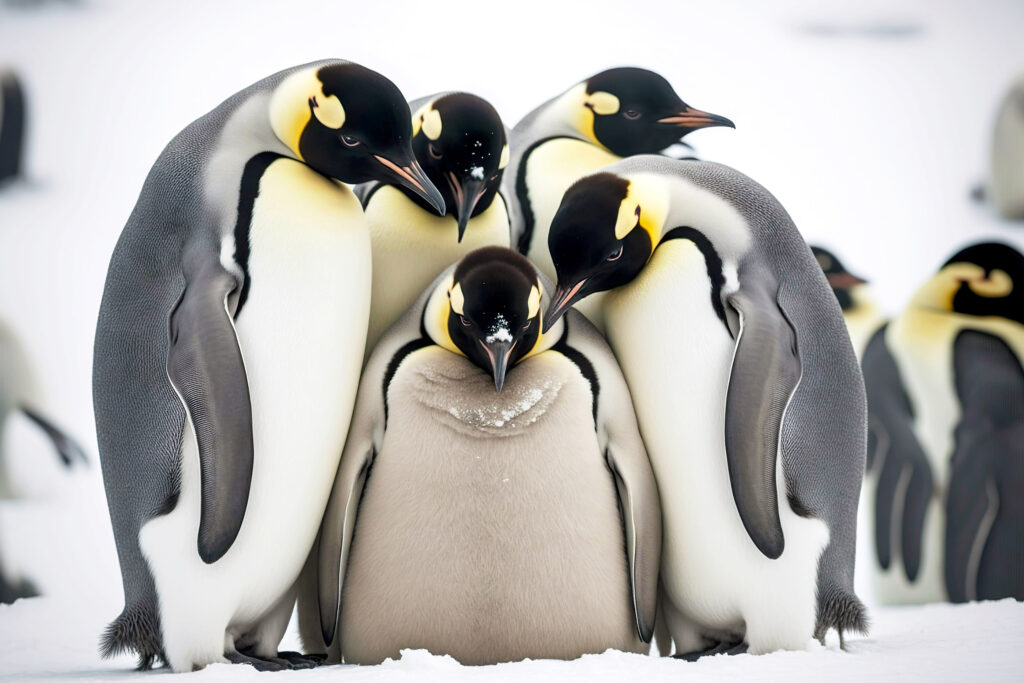
The largest of all penguin species, emperor penguins can grow up to 122cm tall and weigh up to 45kg.
But it’s not just their size that’s impressive. Emperor penguins are incredibly tough and resilient; they’re the only penguin species that breed in Antarctica in the winter, even when temperatures drop as low as -40-50°C.
Emperors spend their time either in the Ocean or on the ice surrounding the continent, feeding on fish, squid, and krill. They are terrific swimmers who can stay underwater for up to 20 minutes and dive to depths of over 550 metres.
Up to 265,000 breeding pairs of Emperor penguins live in Antarctica. Snow Hill Island in the Weddell Sea is one of the best places to see them on an Antarctica cruise, with up to 4,000 individuals in the colony.
2. King penguins
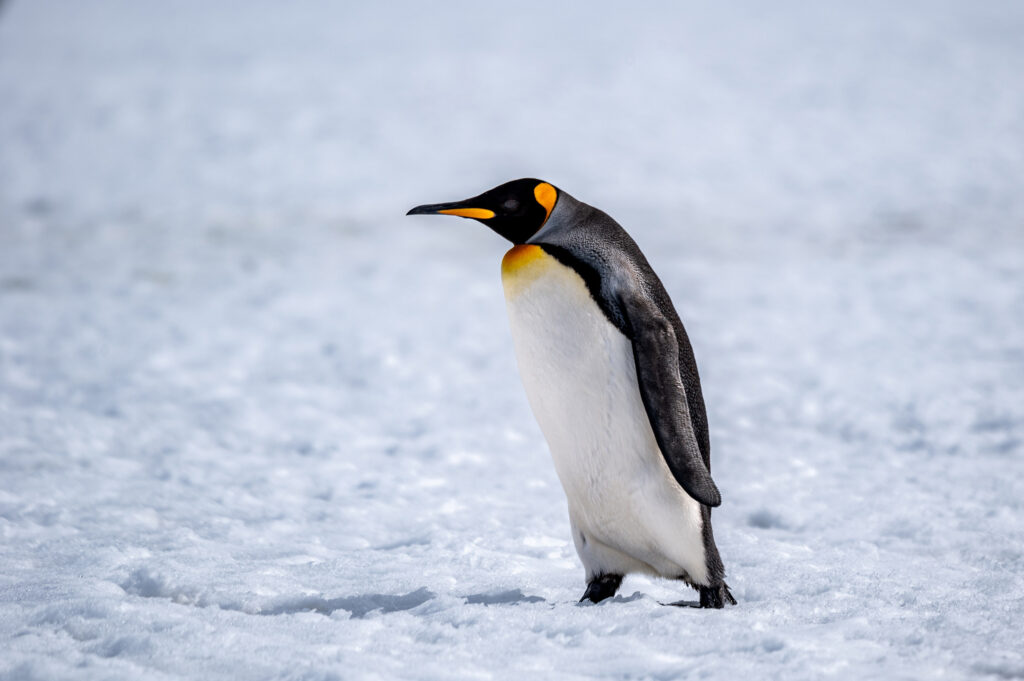
The King penguin is the second largest penguin in the world and a fellow Antarctica resident.
Kings are tall and sleek, with distinctive yellow and orange feathers on their upper chests that stand out against Antarctica’s snowy whiteness.
Male and female king penguins are almost identical, but males are slightly larger, growing up to around 100cm in height. Their down feathers help them stay warm when temperatures plummet and the icy winds pick up. Male king penguins stand on their feet to incubate eggs, covering them with a special pouch to keep them warm.
Despite looking similar to emperors, they’re rarely found together, preferring warmer, Subantarctic waters.
3. Adelie Penguins
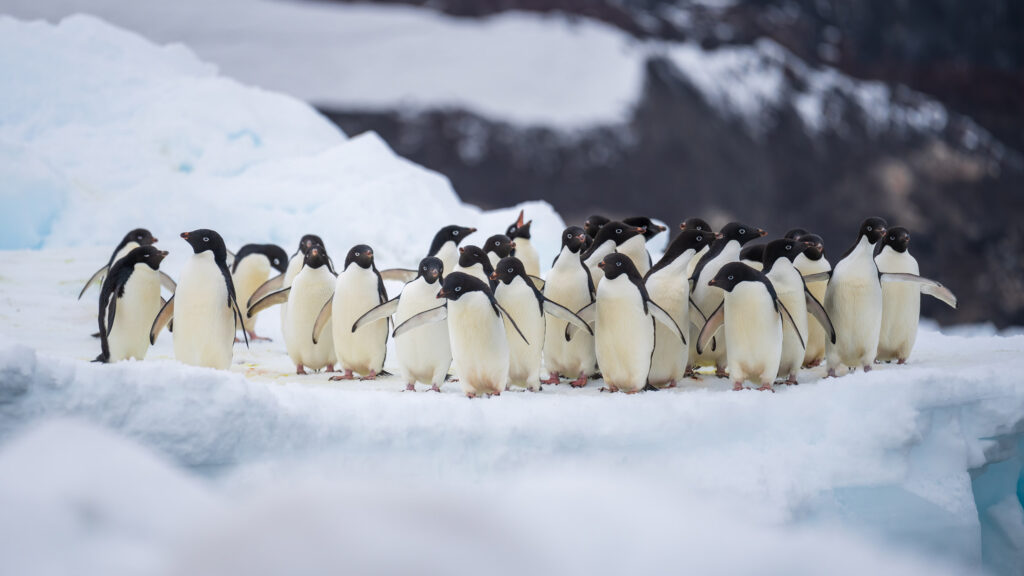
Adélie penguins are endemic to Antarctica, and it’s the only place in the polar regions where you’ll see one. They’re the smallest but most widely distributed penguin species in the Antarctic and are named after a 19th-century French explorer’s wife. They live in Antarctica all year round and are easily identified by the white ring around their eyes.
They’re commonly spotted across Antarctica and can be found on every shore. But like so much wildlife, they’re threatened by climate change, and their population has fallen by over 65% in the past 25 years.
Despite these challenges, they’re efficient foragers and skilled predators and can dive 180m to catch fish and krill in the icy Antarctic seas.
4. Chinstrap Penguins
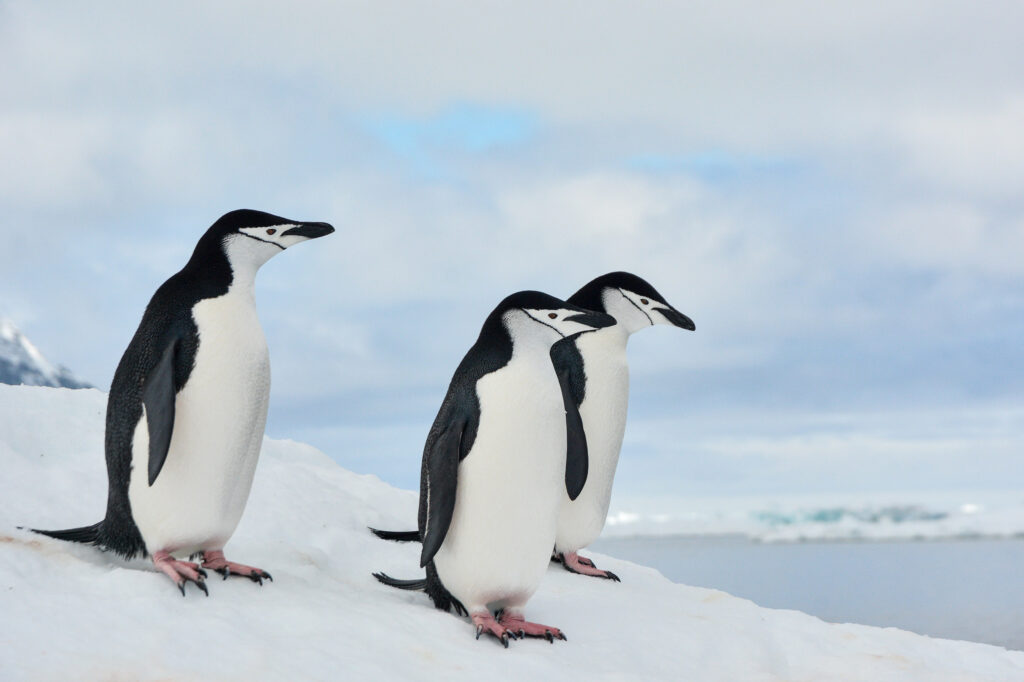
Taking their name from the distinctive black marking under their chins, chinstrap penguins are easy to spot with their thin black beard of feathers. They live in colonies of hundreds of thousands on the northern Antarctic peninsula and the South Shetland islands.
Although their sound may be the first thing you notice, chinstrap penguins are one of the most raucous and vocal penguin species.
They can be found in large numbers across the Antarctic, but the biggest colony is on Zavodowski Island in the South Sandwich Islands, which is an active volcano and home to 1.3 million chinstraps.
5. Macaroni Penguins
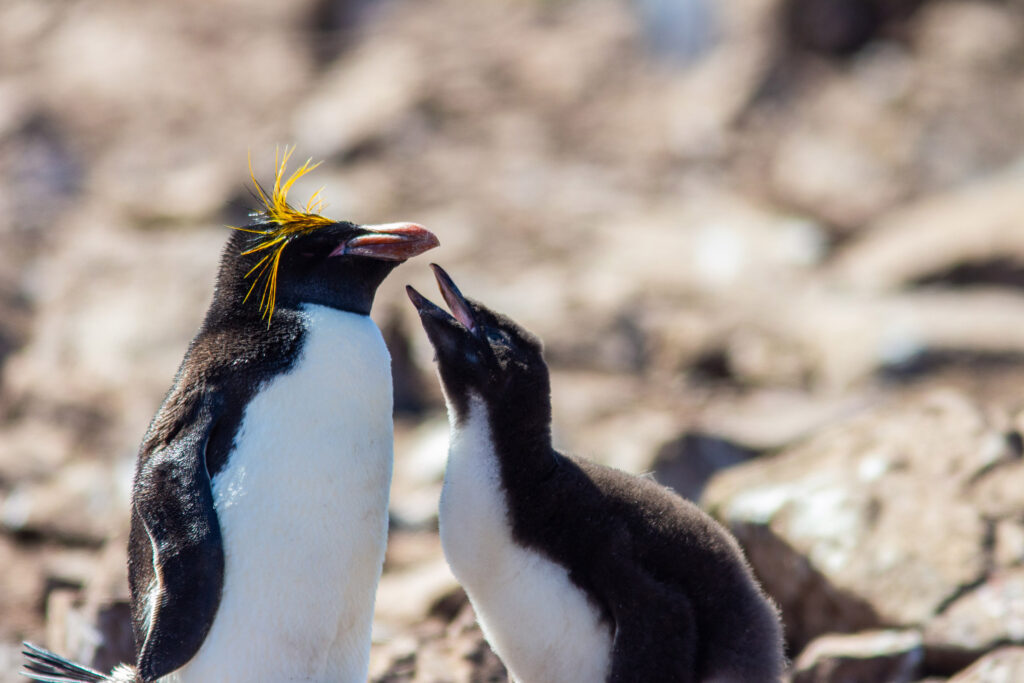
Named after an 18th-century slang term rather than a pasta shape, a far more obscure reference to 18th-century slang, Macaroni penguins stand out in Antarctica thanks to their distinctive yellow crests.
They are the largest of the crested penguin species. The largest population of macaroni is on South Georgia Island, where there are 3.5 million of them. During the breeding season, Macaroni penguins consume more krill than any other seabird in Antarctica.
6. Gentoo Penguins
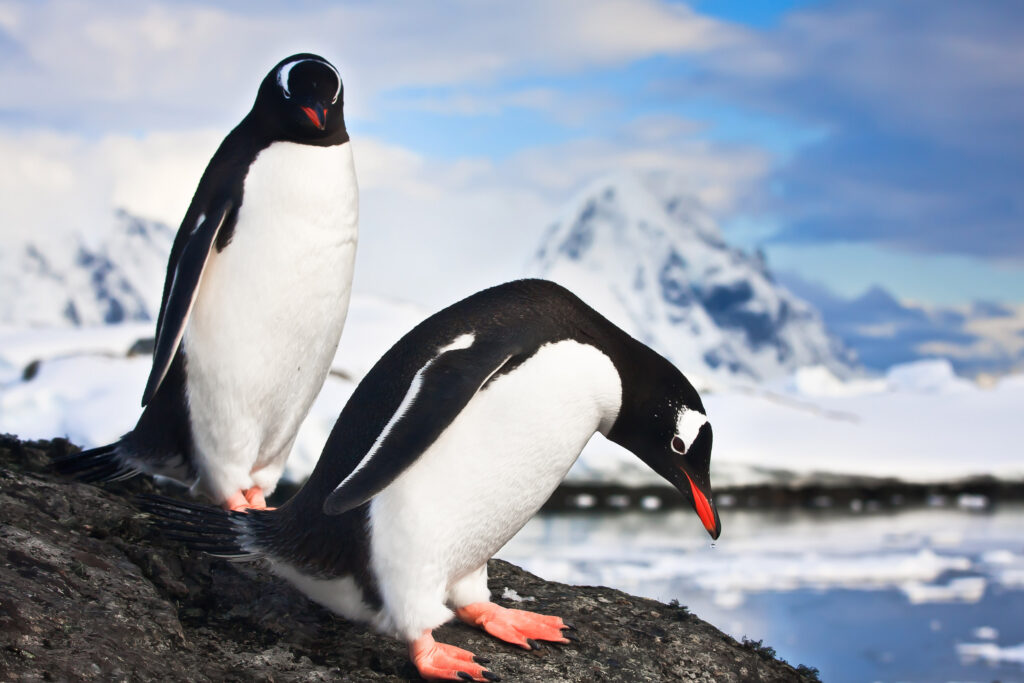
Gentoo penguins are a close relative of the Adélie and chinstrap. They are the fastest-swimming penguins in the world and can raise up to two chicks per year.
They’re also speedy swimmers, reaching speeds of up to 22.4 mph. They’re also expert divers, reaching depths of up to 200m and can stay underwater for up to seven minutes.
Gentoos are the third largest of all species; appearance-wise, they are black and white with a splash of white around the eyes and bright orange beaks. They also have prominent tails that stick out and sweep from side to side as they walk.
7. Rockhopper Penguins
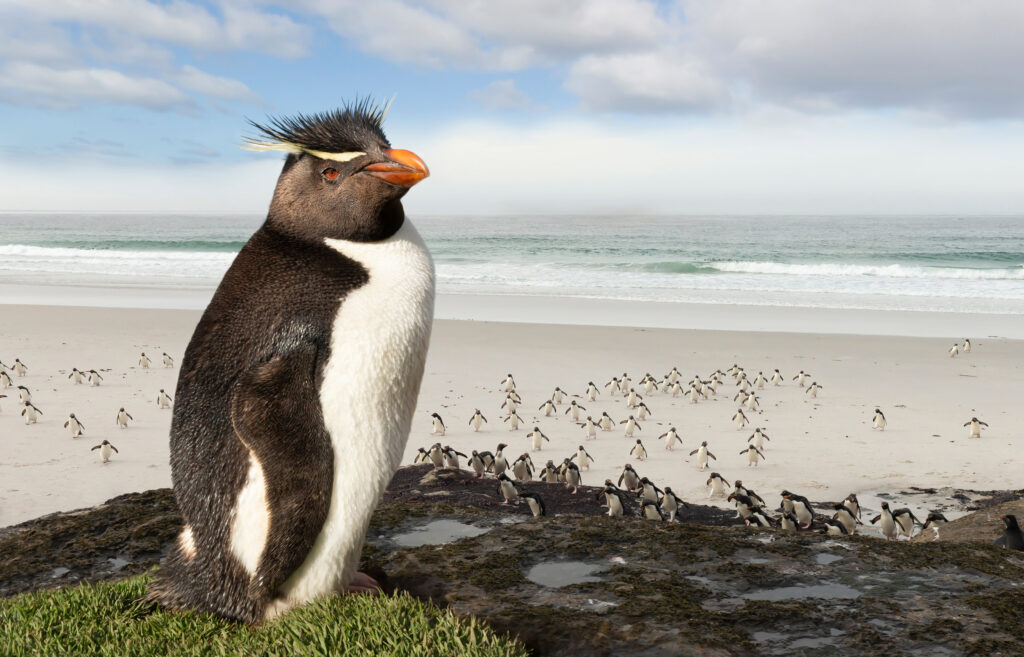
Technically, it is a subantarctic species rather than an Antarctica species (the Falkland Islands and South Georgia are particularly good for spotting them), and rockhoppers look like the smaller sibling of macaroni penguins.
Rockhoppers are the smallest penguins living in polar regions, standing under 55cm. And yes, their name is literal; they can be found leaping around the craggy rocks of the shoreline to build rookeries.
To learn more about how to see Antarctica Penguins please see our guide.
Antarctic Seals
Antarctica is also home to six species of seals. These seals are well adapted to the extreme cold and play a critical role in the Antarctic ecosystem.
8. Antarctic Fur Seals
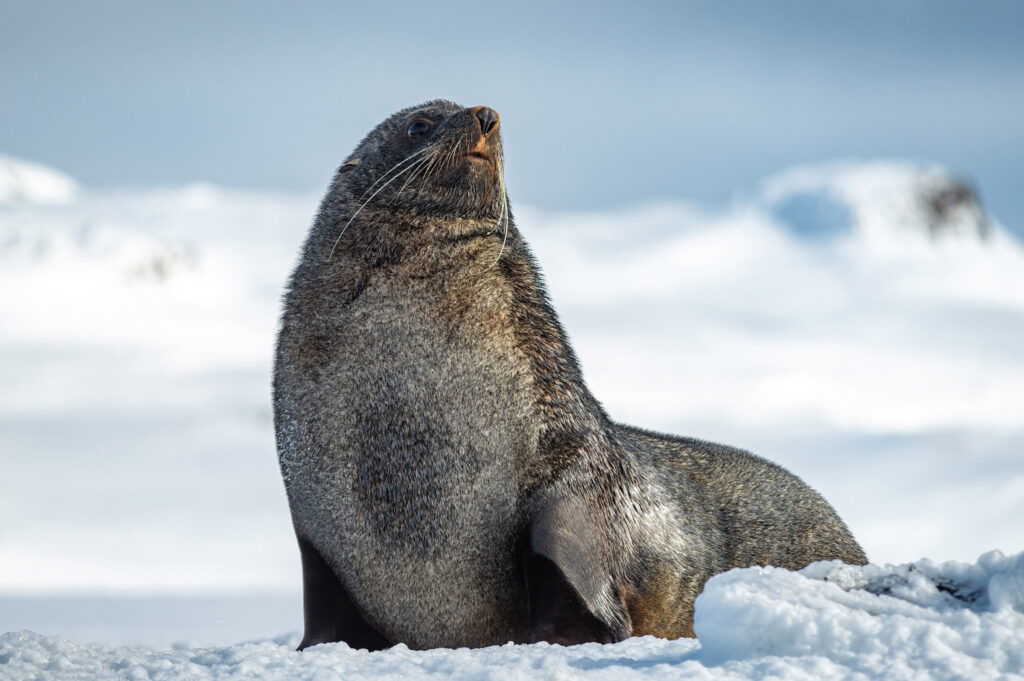
The Antarctic Fur Seal symbolises the resilience of Antarctica’s wildlife. Once hunted to near extinction, they now thrive and are widely distributed in the Antarctic and Subantarctic. In the summer, they tend to breed in colonies on Subantarctic islands.
Antarctic fur seals have thick, waterproof fun, which makes them well adapted to life in Antarctica. They’re also fast movers, reaching speeds of up to 20kpm (12.4m) on land and higher while swimming.
They’re also the only species of seal with visible ears in Antarctica. Unlike other seals, they can stand on their flippers to look taller and walk.
Antarctic fur seals were nearly extinct in the early 20th century, but now populations have recovered and can be seen in abundance.
9. Southern Elephant Seal
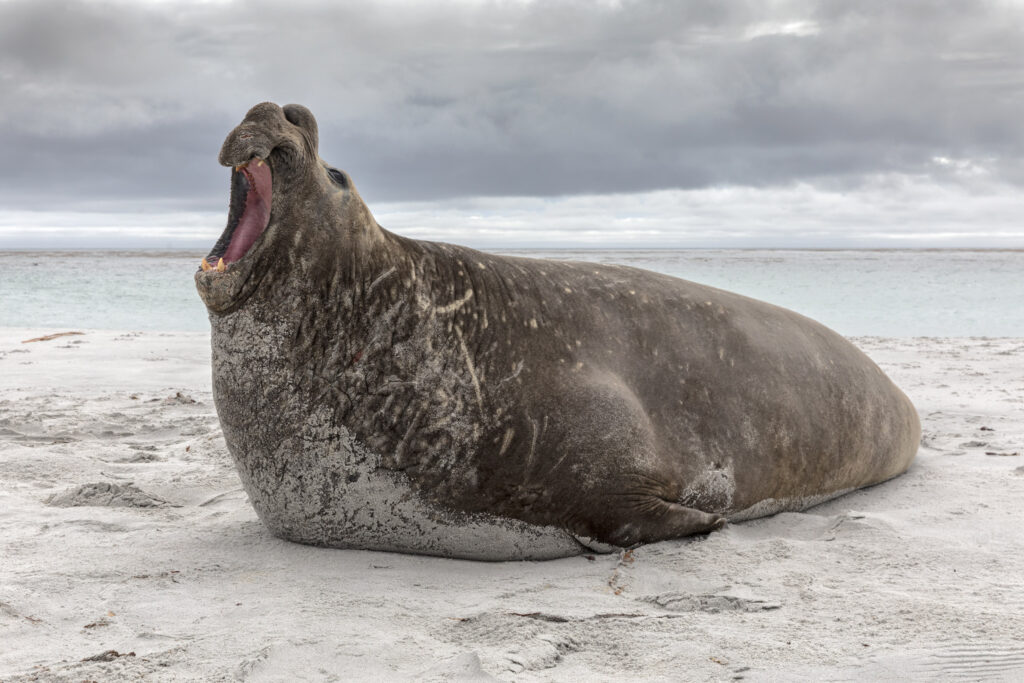
Southern elephant seals are the largest species of seal on Earth (along with northern elephant seals). They are large and loud. Male elephant seals can weigh up to 3,700kg, which is heavier than northern elephant seals.
Getting their name from their elephant-like nose, they’re even nosier, using their sounds to communicate their size and strength using a combination of roars, rattles and pulses.
Southern elephant seals can often be spotted along Antarctica’s coastlines, where they swim or nurse.
10. Weddell Seal
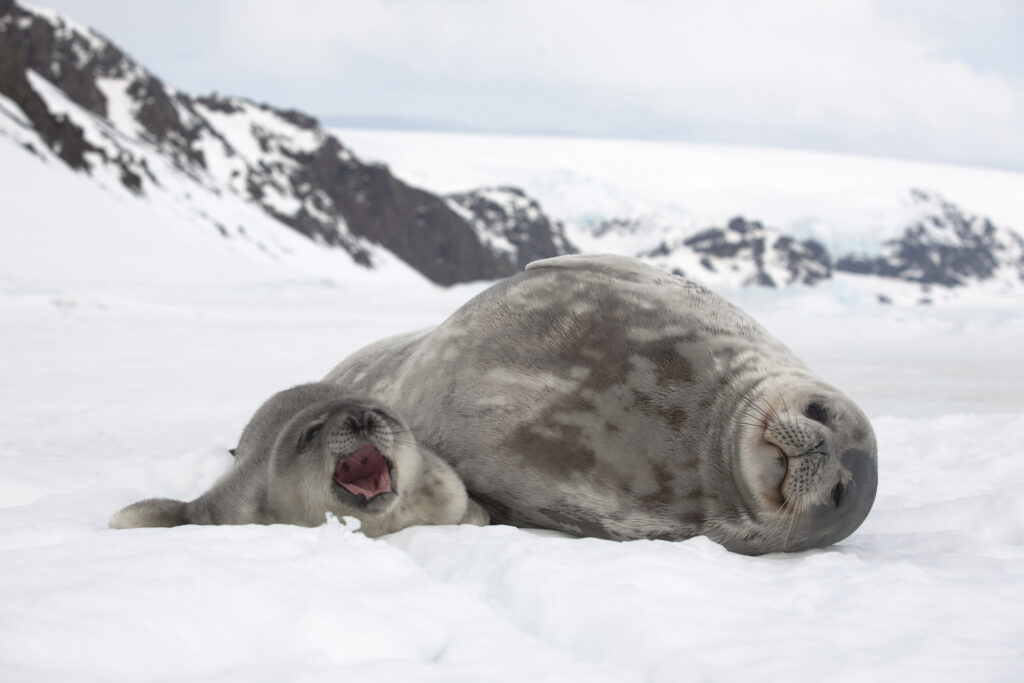
True ice-dwellers, Weddell Seals live further south than any other mammal. They haul out onto the sea ice to breed and return to the same area yearly.
Named after British sailor and navigator James Weddell, they can dive for and stay submerged for up to 80 minutes and have excellent underwater vision.
These adaptations help them hunt for fish, crustaceans, squid, penguins and even seals! They can dive for periods of up to 80 minutes underwater while hunting.
Both males and females grow to around 3 metres, weigh around 400-500g, and have relatively small heads.
11. Leopard Seals
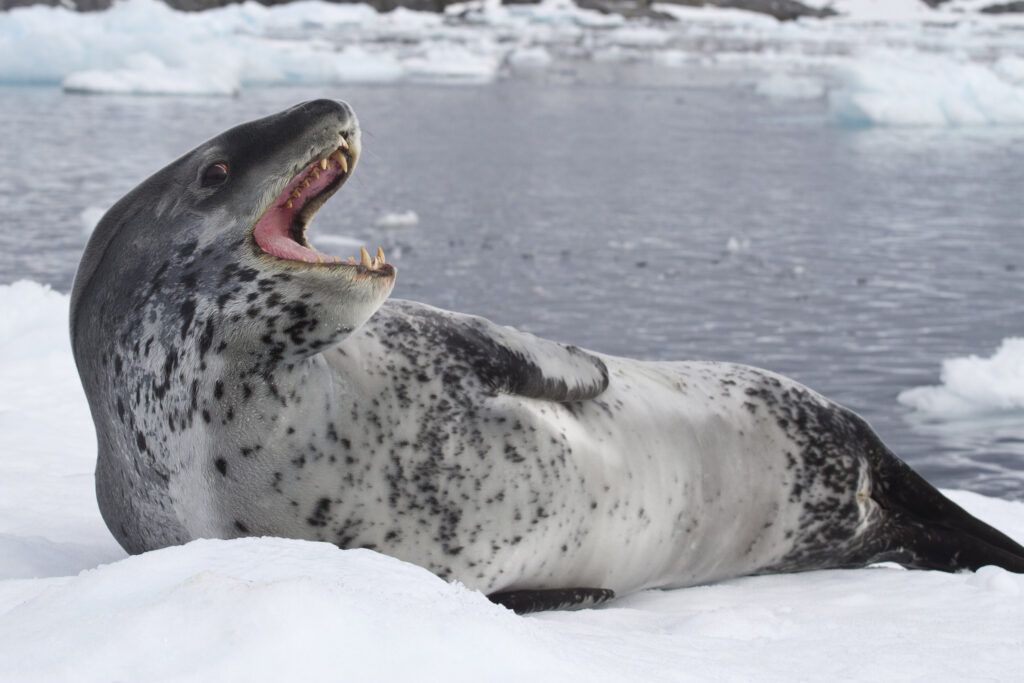
As the name suggests, Leopard Seals are spotted and sleek. They’re the second largest species in Antarctica and fierce hunters with powerful jaws and sharp teeth.
Leopard seals are apex predators that feed on fish, krill, and penguins. They are the only seal species that actively hunt other mammals.
12. Crabeater Seals
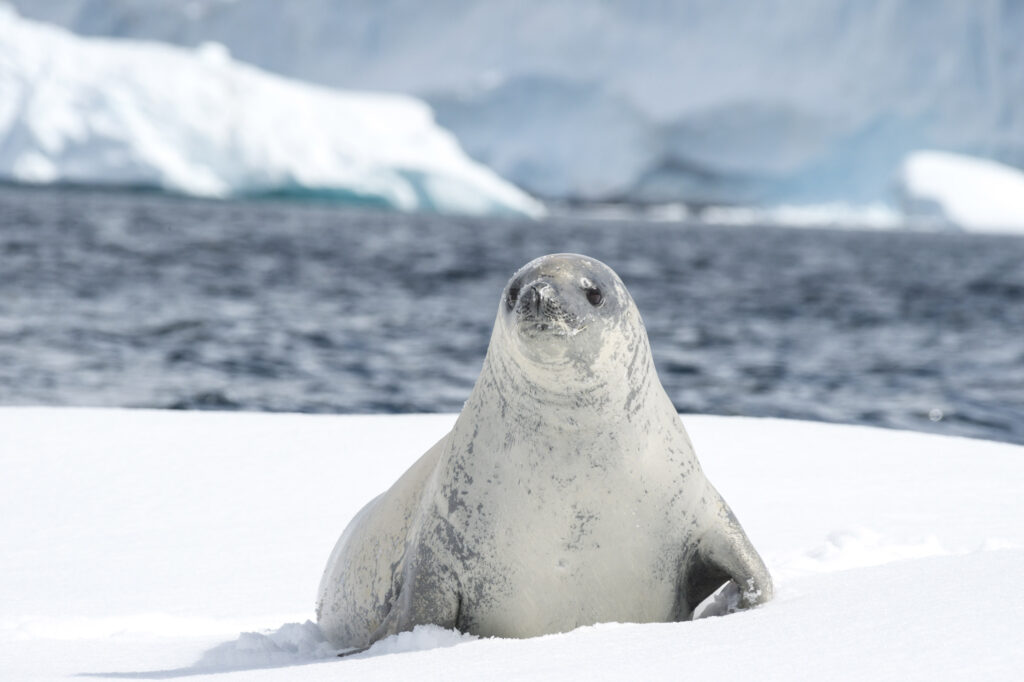
Crabeater seals have an estimated population of 15 million, making them one of the most numerous seal species in Antarctica. Unlike their name suggests, they do not eat crabs but krill, which makes up 90% of their diet.
13. Ross Seals
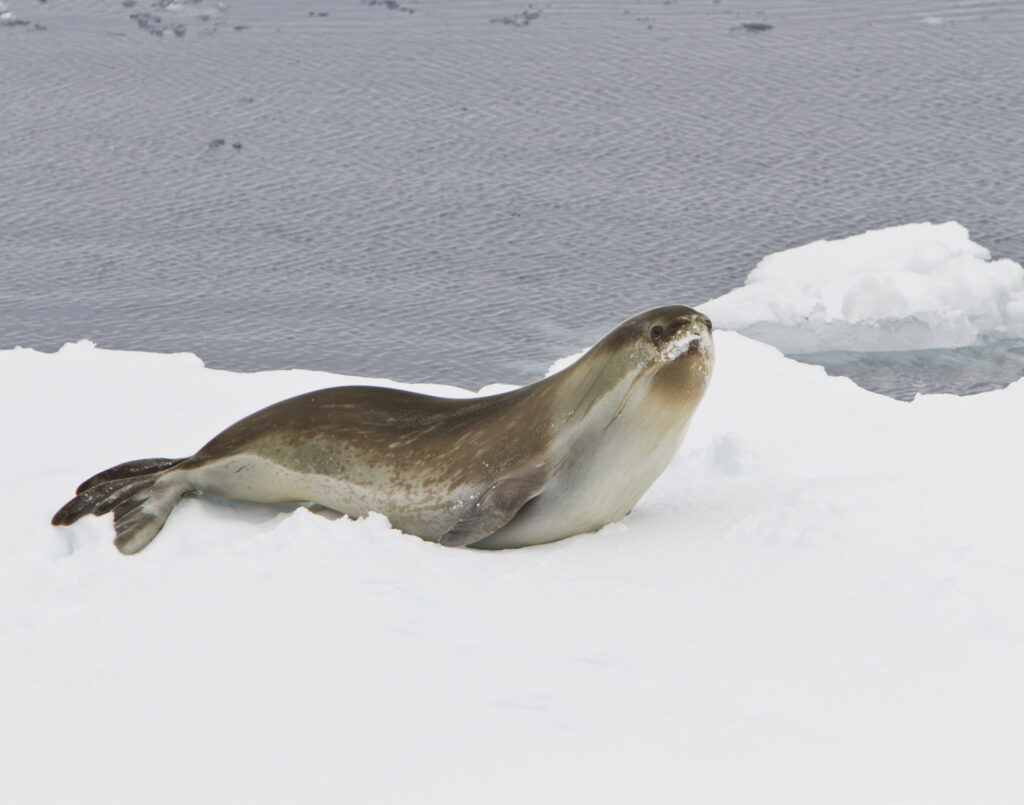
Ross seals are solitary hunters that live on Antarctic pack ice. They are the smallest seals living in Antarctica and the rarest seal species in the Southern Ocean.
Whales
Antarctica also has several whale species migrating to and from other oceans. The Antarctic Ocean (or Southern Ocean) has been a designated whale sanctuary since 1994.
Whales you might find in Antarctica include:
14. The Blue Whale
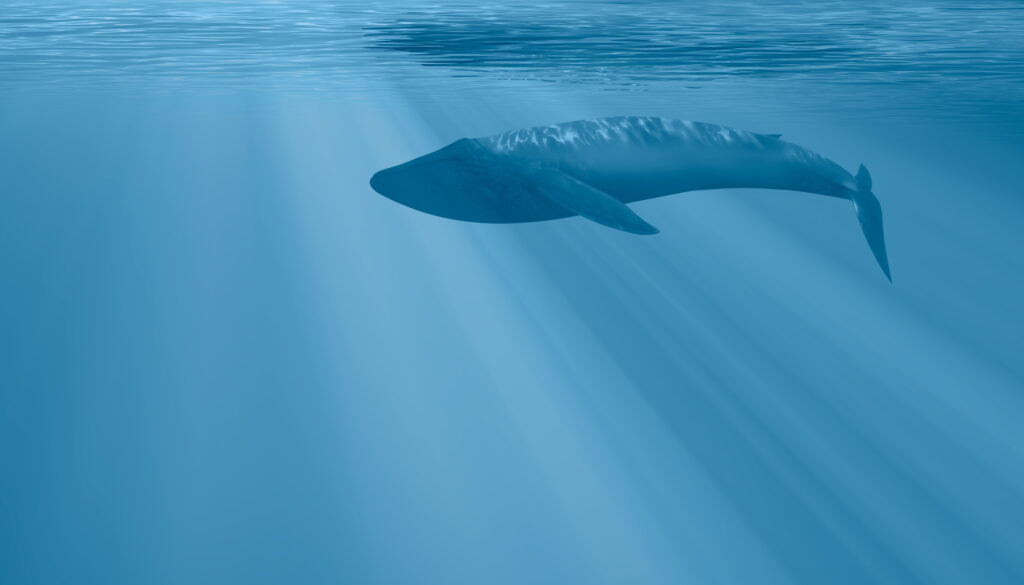
The apex predator of the Ocean and the largest animal to have ever existed, the blue whale weighs a colossal 150 tonnes. This is impressive mainly because it largely feeds on krill, which are roughly the size of shrimp.
A blue whale can consume 3600kg of krill per day and has a low-frequency call that can be heard hundreds of miles away.
But for all its might, the blue whale is critically endangered. This is mainly due to decades of commercial whaling during the 20th century, which continued until 1972.
But, thanks to conservation efforts by organisations like WWF, sightings of Antarctic blue whales are becoming more common. In 2020, the British Antarctic Survey (BAS) counted 55 during their expedition in the sub-Antarctic waters around South Georgia.
15. Humpback Whale
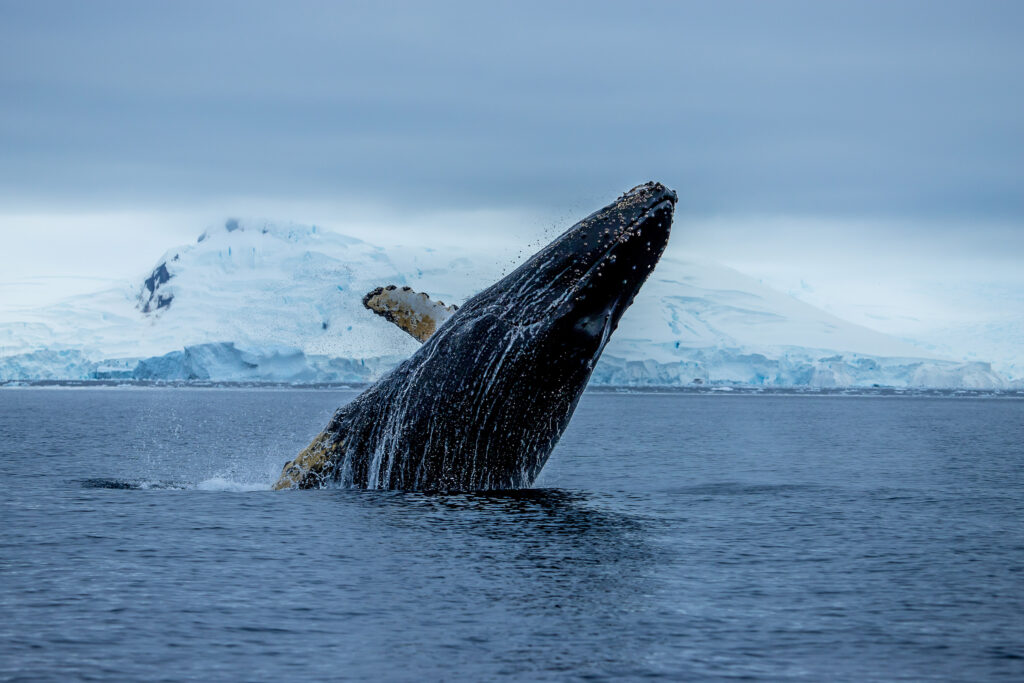
There’s a good chance of spotting humpback whales on an expedition to Antarctica. They’re easy to spot, thanks to the distinctive hump as well as small dorsal find and black and white tails.
Humpback whales migrate to Antarctica during the summer months to feed on kills. They have between 270 and 400 baleen plates rather than teeth. They can measure up to 18 metres and weigh around 30-40 tonnes.
You might also hear males and their distinctive song, which can last for 20 minutes and is used to attract mates and assert dominance over their rivals.
16. Orcas
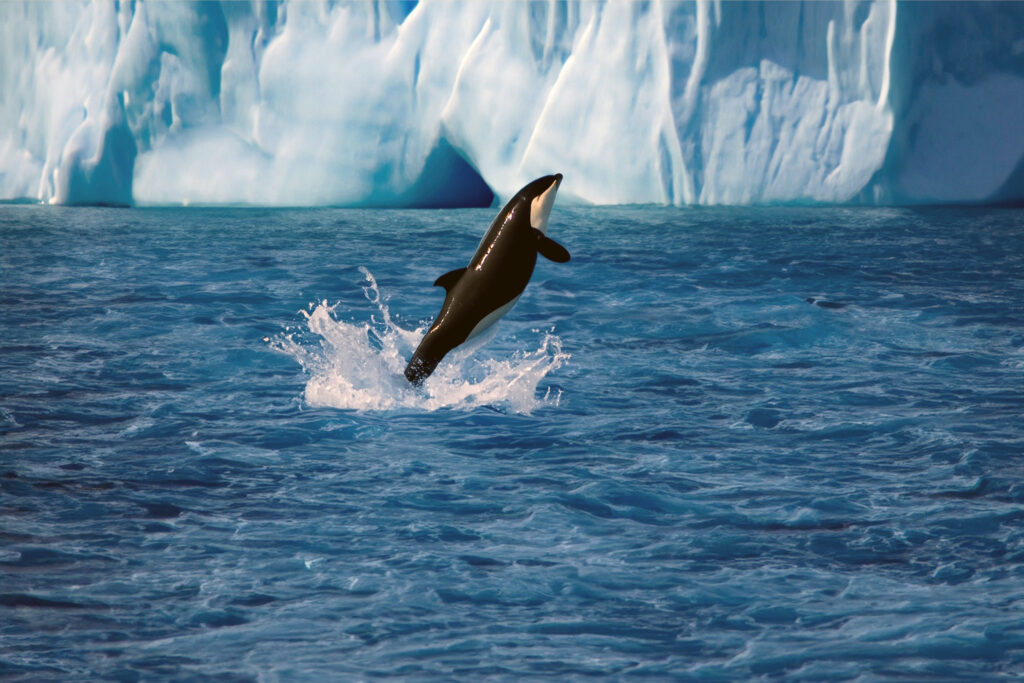
Also known as killer whales, orcas are the largest members of the dolphin family. Males can measure up to 9.8 metres, while females are smaller and can weigh up to 5,500 kg.
Orcas can live up to 90 years, and females live longer than males. They are found all around the world and migrate huge distances.
Their thick layer of blubber makes them very well adapted to Antarctica’s extreme cold, and their streamlined bodies make them excellent swimmers. The best months for spotting orcas in Antarctica are February and March.
17. Minke Whales
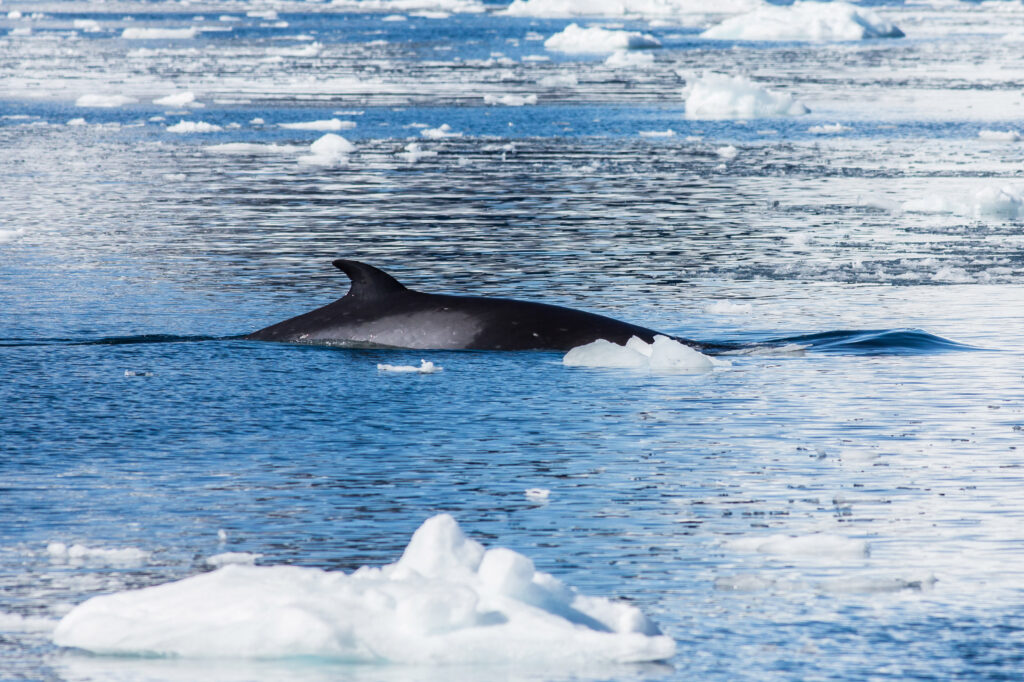
Minke whales are the smallest members of the baleen species. They grow to around 7-10 metres and weigh 5-10 tonnes. Minke whales are sleek and agile.
They’re skilled divers, plunging to depths of up to 240 metres where they can scoop up large quantities of fish. Minkes also produce interesting sounds, including boings and clicks at low frequencies. They are curious creatures and often swim close to ships in Antarctica.
Antarctica Birds
Antarctica is home to over 100 million breeding birds, and it’s one of the best places in the world to birdwatch and see a diverse range of species.
There are many endemic bird species that you won’t find anywhere else on Earth.
18. Albatrosses
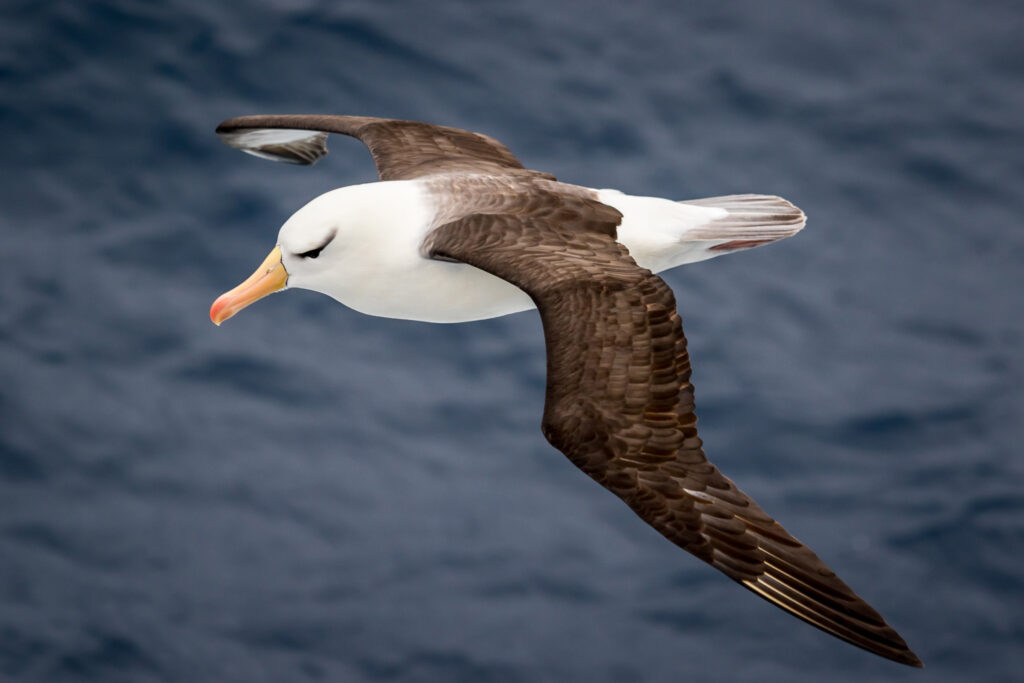
Antarctica is home to several Albatross species, so there’s a good chance of seeing them on an expedition cruise.
On your travels, you may encounter the magnificent wandering albatross, also known as the snowy albatross. This bird has the largest wingspan of any bird in the world.
Their wings measure up to 3.5 metres, they can fly over 500 miles a day, and they can live for up to 50 years.
The southern royal albatross is also commonly spotted in Antarctica. These noisy birds use loud calls, gulps, claps, and bill snaps to try to attract mates.
Other albatrosses you might be lucky enough to spot include the black-browned albatrosses. Although they are migratory, over 70% live on the Falkland Islands.
Antarctica is also home to the solitary, light-mantled albatross, which builds nests high on the cliff faces away from the harsh Antarctic winds.
19. Petrels
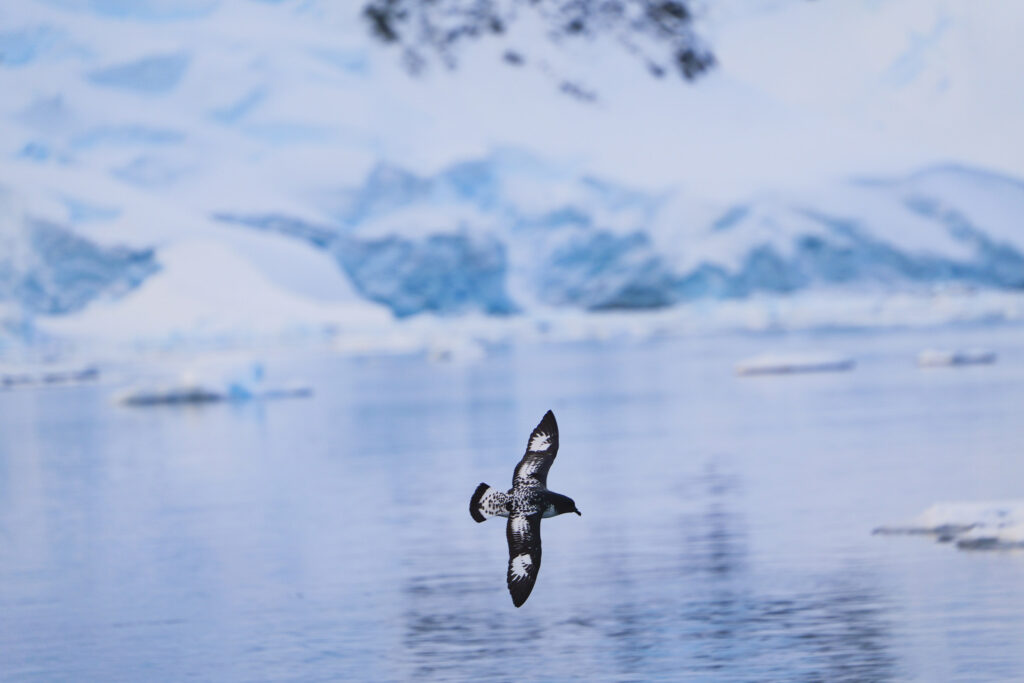
Several petrel species live in Antarctica, including the Antarctic petrel, a dark brown and white seabird that breeds in large colonies of up to 200,000 pairs in October and November.
Antarctica is also home to an abundance of snow petrels, which are, as the name suggests, all-white birds.
Snow petrels can often be spotted in flocks on pack ice and ice floes, and they are easier to spot as they fly low over the water in search of fish, squid, and molluscs.
Other petrel species that can be found in Antarctica include the tiny but mighty Wilson’s storm petrel. This is actually the smallest bird that breeds there, but it is very well adapted to the region’s harsh conditions.
Antarctica is also home to black-bellied storm petrels, which tend to fly solo but make a lot of noise within breeding colonies, often making high-pitched whistles.
20. Antarctic Tern
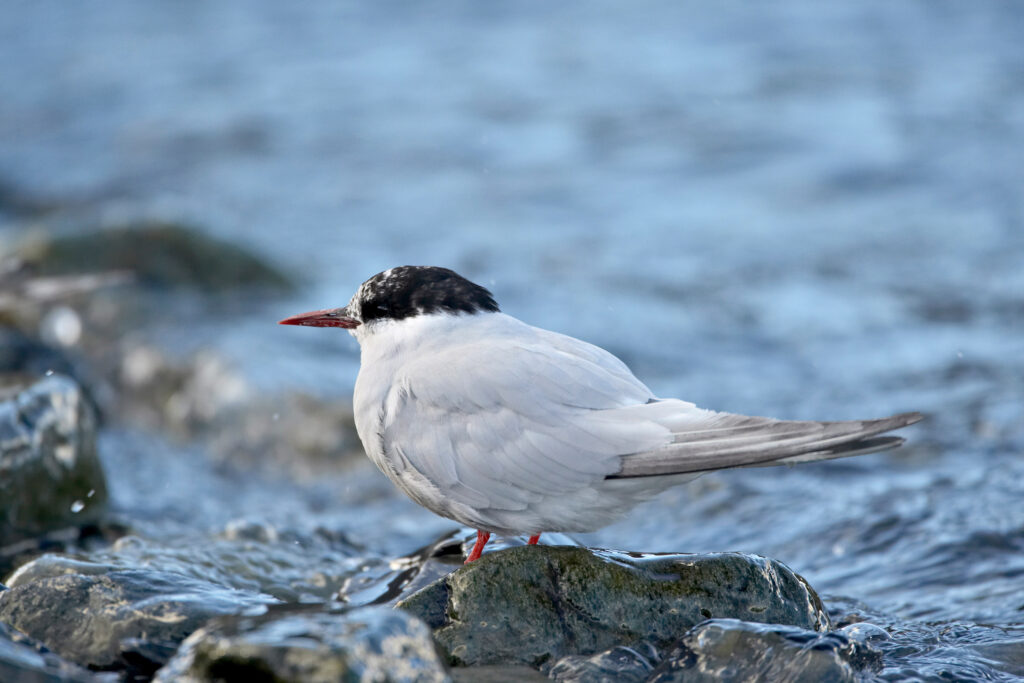
Antarctic terns are similar in appearance to the Arctic terms but are stockier and have grey rather than black wing tips. They’re also not migratory and can be found in Antarctica all year round.
21. Kelp gull
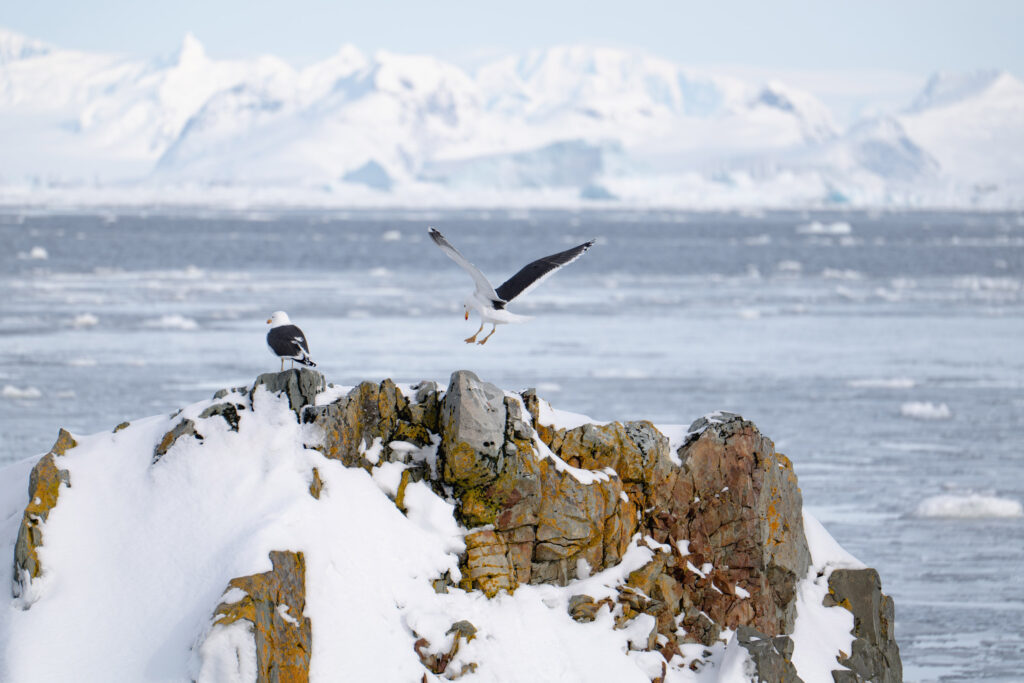
Also known as the Dominican or southern gull, the kelp gull is the only gill species in the Antarctic. It looks similar to the many gulls that live further north and has distinctive orange spots on its bills.
For a comprehensive overview of Antarctica birds please check out our article on the 30 most common birds you can find on an Antarctic cruise.
Fish
Fish are crucial to Antarctica’s ecosystem, providing vital food for its predators, including blue whales, seabirds and leopard seals.
Antarctica’s waters are home to Antarctic cods (which differ from other cod), krill, squid and octopus.
They are also home to a unique group of fish species called notothenioid, which have adapted to live in extremely cold water. Icefish are a subgroup of notothenioid and are the only vertebrates without red blood.
Up to 90% of fish species found south of the Antarctic Convergence are endemic.
Conservation and Threats to Antarctica Wildlife
Much like the Arctic, climate change seriously threatens Antarctica and its vital ecosystem. The west coast of the Antarctic Peninsula has a mean annual temperature rise of 3°C, making it one of the most rapidly warming regions on Earth.
In February 2021, Antarctica recorded its hottest temperature, 18.3°, at its northernmost tip, the Esperanza Station.
The declining sea ice has been devastating for emperor penguins, as it’s a crucial breeding ground for them. Some colonies have declined by up to 50%.
However, scientists and researchers do crucial work in Antarctica, and there have been some remarkable advances in technology in recent years, including NASA’s ICE SAT, which uses satellites to produce high-resolution images that track changes in the sea ice.
The Antarctic Treaty came into effect in 1961 to protect all animal and plant life in Antarctica. This helps to reduce the killing or capture of animals (apart from specific scientific purposes) and control the introduction of non-native animal or plant species.
It also includes the establishment of protected areas and species and helps to reduce harm from pollution.
How to See Wildlife In Antarctica
- The best way to see wildlife in Antarctica is to join an expedition cruise.
- We highly recommend joining a small-ship expedition if wildlife watching is your priority.
- To see Emperor penguins, you must join a specialised tour that visits Snow Hill Island.
- Watch out close to breeding colonies, and always maintain the advised distance
- Always follow the advice of your guide – they know the regions and species the best
- Keep noise to a minimum and avoid using the flash on your camera
What’s the best time of year for wildlife watching in Antarctica?
In general, most expeditions visit Antarctica during the summer months between November and March; this is when you’re most likely to see wildlife, and the days are longer.
Temperatures will be milder than in winter and, between December and February, are more often above freezing. Antarctica wildlife is most active between December and February.
Are you looking to travel to Antarctica? At Polar Escapes, we are experts in polar travel. Here, you can find and book the largest range of expedition cruises and tours to Antarctica.
If you need expert advice on Antarctica wildlife, when to visit, and what to see, please don’t hesitate to contact us.
Thanks for reading, and happy exploring.
Most emails are boring.
Ours are cool.


